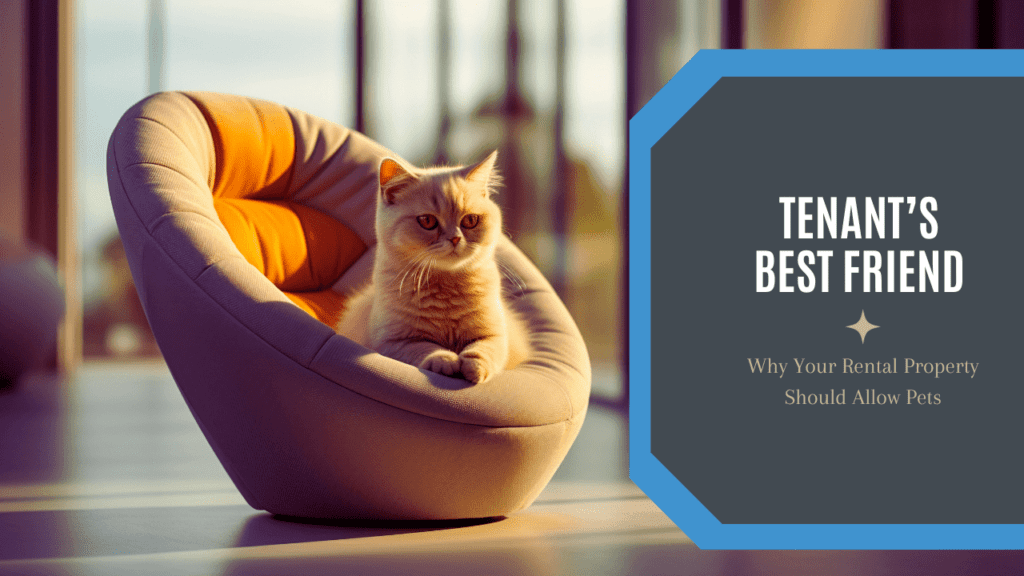
If you don’t allow pets in your rental property, you could quickly find yourself in the doghouse.
That’s because pet-friendly properties rent for more money, attract more tenants, and contribute to better tenant retention.
Statistically, a majority of the tenants in and around the South Bay have at least one pet. When it’s time to look for a new place to live, do you think they’re even going to consider a place that won’t allow their furry family member?
They will not.
We always recommend that your rental property allow pets. We also understand the risk and liability that can come with allowing pets inside of your investment. If you have a strong pet policy in place and a property management team that’s willing to enforce it, that risk is dramatically diminished.
Let’s talk about why pet-friendly properties are tenant-friendly properties.
Limiting Vacancy and Appealing to a Larger Tenant Pool
Most tenants, when they begin their search for a rental home, are looking for a price that’s in their budget, a desirable location and neighborhood, and a home that’s well-maintained and attractive. They want to be safe and comfortable.
They also want their pets to be safe and comfortable, too. That’s why it’s a good idea to offer a pet-friendly property. When your listing says you allow dogs and cats, you’ll get immediate attention from the majority of tenants on the market – pet owners.
Whether you love animals or can easily live without them, it’s really a numbers game when it comes to the decision whether or not to allow pets. Statistics show that more than 60 percent of renters have at least one pet. So, if you refuse to even consider pets, you’re eliminating more than half of your tenant pool. That’s likely to lead to increased vacancy time. Do you want to risk a longer vacancy?
You don’t have to allow every pet. In fact, there should be restrictions, and we’ll talk about that later when we reference your pet policy. In your listing, say that pets will be considered. That signals to pet owners that they should come and see your property. But, it doesn’t guarantee that you’re going to allow an entire litter of kittens to move into your one-bedroom rental property.
Allowing pets will speed up your leasing time. You’ll find a tenant faster. But, the benefits go even further. You’ll also:
- Attract good tenants. Renters with pets typically understand that not every home is going to welcome them. Good pet owners are usually good tenants. They take care of their pets and they take care of your property.
- Increase your retention rate. Again – pet owners know that finding a new home would only be a hassle. There’s likely to be another pet fee or deposit to pay. If they like where they’re living and they can keep their pets happy, your tenants are likely to renew the lease agreement at the end of the tenancy, protecting you from vacancy and turnover costs. Studies have shown that tenant retention is higher among residents who own at least one pet.
Your pet-friendly policies will attract a wider range of tenants and allow you to rent your property quickly. This means less vacancy and a lower risk of turnover when the lease period is over.
Pet-Friendly Landlords Earn More Money on Their Rental Homes
Allowing pets means you can charge a pet fee. A fee is fantastic because it’s non-refundable.
Tenants will expect to pay a pet fee when they rent a home. This pet fee is collected as protection against the potential for pet damage. Even if the pet is perfectly behaved and you don’t have any damage to deal with, you get to keep the pet fee. That’s a couple of hundred dollars extra when you have a tenant moving in with their pet.
Let’s remember that it’s normal to collect a per-pet fee. So, if your pet fee is $300 per pet and a tenant moves in with one cat and one dog, that’s $600 in fees alone.
There’s also pet rent, which many landlords collect. Pet rent is just like human rent – there’s a specific amount of money that will be paid for each pet living in the property. Maybe it’s $25 per pet or $50 per pet. Whatever you charge, you’ve increased your monthly rental value simply by allowing pets into your property.
Some landlords will collect a pet deposit instead of a fee. This is another option, and there are pros and cons to it:
- A pet deposit is refundable. You have to give the money back to the tenant when they move out unless there was pet damage that you had to repair.
- This can be an incentive. When tenants with pets know that they can get their pet deposit back, they may be more likely to prevent any potential damage.
You could do a pet deposit, but the pet fee not only covers potential costs…it also gives you some extra cash flow if the money isn’t used. We’ve seen pet fees up to $500 per pet. Most landlords will charge $200 or $300 per pet.
Protect Your South Bay Rental with a Strong Pet Policy
 A good pet policy will protect your investment property and tell tenants what you expect in terms of behavior, maintenance, and cleanliness. Establish limits and guidelines in your pet policy as well.
A good pet policy will protect your investment property and tell tenants what you expect in terms of behavior, maintenance, and cleanliness. Establish limits and guidelines in your pet policy as well.
Maybe you want to have a maximum of one pet per property. That’s fine. Or, you can allow two pets; one dog and one cat or two dogs. These are reasonable restrictions and they still allow you to earn more on your property.
Check your insurance policy as well because you may need to have some breed restrictions for dogs. Pit Bulls, for example, are on nearly every list of restricted breeds. If something happens at your property involving a Pit Bull, your insurance company may not cover you. Your pet policy should let your applicants know what kind of dogs are and are not allowed.
Don’t bark up the wrong tree. Contact us at South County Property Management. We serve Santa Clara County and South County, including San Jose, Campbell, Saratoga, Cupertino, Sunnyvale, Los Gatos, Milpitas, Morgan Hill, Gilroy, and neighboring areas.
